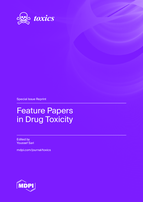Feature Papers in Drug Toxicity
A special issue of Toxics (ISSN 2305-6304). This special issue belongs to the section "Drugs Toxicity".
Deadline for manuscript submissions: closed (30 September 2023) | Viewed by 19832
Special Issue Editor
Interests: alcohol dependence; methamphetamine; cocaine; nicotine; opioids; electronic cigarettes; drug dependence; glutamate transporters
Special Issue Information
Dear Colleagues,
Drug toxicity is a major problem involving neurotoxicity and organ injury. There are many drugs that have toxic effects as a result of acute or chronic exposure. Among these drugs are drugs of abuse, such as alcohol, methamphetamine, opioids, cocaine, cathinone, electronic cigarette, and cannabis-related chemicals. Understanding the pharmacological and toxicological nature of these drugs of abuse would expand research in the field of neurotoxicity and organ toxicity. It is unclear whether there are differences in acute vs. chronic exposure in terms of drug-induced toxicity and gender.
As part of this Special Issue, we are very pleased to invite investigators and scientists from different research areas to present papers related to drugs of abuse in animal models and clinics. This will involve publications of original research, review articles and research method articles. Research areas may include, but are not limited to, the following:
- Alcohol-induced neurotoxicity;
- Cocaine-induced neurotoxicity;
- Methamphetamine-induced neurotoxicity;
- Opioid-induced neurotoxicity;
- Cannabis-induced neurotoxicity;
- Cathinone-induced neurotoxicity;
- Lysergic acid diethylamide (LSD)-induced neurotoxicity;
- Ecstasy-induced neurotoxicity;
- Electronic cigarette-induced neurotoxicity;
- Drugs-of-abuse-induced liver toxicity and damage to other organs.
Prof. Dr. Youssef Sari
Guest Editor
Manuscript Submission Information
Manuscripts should be submitted online at www.mdpi.com by registering and logging in to this website. Once you are registered, click here to go to the submission form. Manuscripts can be submitted until the deadline. All submissions that pass pre-check are peer-reviewed. Accepted papers will be published continuously in the journal (as soon as accepted) and will be listed together on the special issue website. Research articles, review articles as well as short communications are invited. For planned papers, a title and short abstract (about 100 words) can be sent to the Editorial Office for announcement on this website.
Submitted manuscripts should not have been published previously, nor be under consideration for publication elsewhere (except conference proceedings papers). All manuscripts are thoroughly refereed through a single-blind peer-review process. A guide for authors and other relevant information for submission of manuscripts is available on the Instructions for Authors page. Toxics is an international peer-reviewed open access monthly journal published by MDPI.
Please visit the Instructions for Authors page before submitting a manuscript. The Article Processing Charge (APC) for publication in this open access journal is 2600 CHF (Swiss Francs). Submitted papers should be well formatted and use good English. Authors may use MDPI's English editing service prior to publication or during author revisions.







